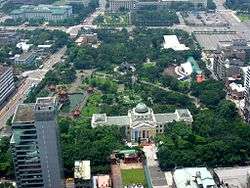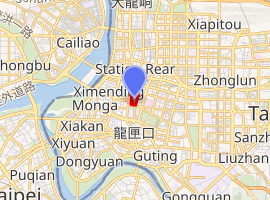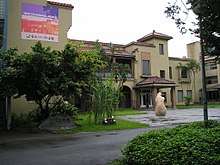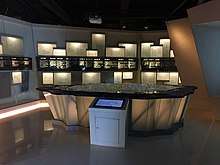228 Peace Memorial Park
The 228 Peace Memorial Park is a historic site and municipal park located at 3 Ketagalan Boulevard, Zhongzheng District, Taipei, Taiwan. The park contains memorials to victims of the February 28 Incident of 1947, including the 228 Memorial Monument that stands at the center of the park and the Taipei 228 Memorial Museum, housed at the site of a former radio station that operated under Japanese and Kuomintang rule. The National Taiwan Museum stands at the park's north entrance. The park also has a bandshell and exercise areas.
| 228 Peace Memorial Park | |
|---|---|
 | |

| |
| Type | Municipal |
| Location | Zhongzheng, Taipei, Taiwan |
| Area | 71,520 m2 |
| Created | 1900 |
| Open | All year |
| 228 Peace Memorial Park | |||||||||||||
|---|---|---|---|---|---|---|---|---|---|---|---|---|---|
| Traditional Chinese | 二二八和平紀念公園 | ||||||||||||
| Simplified Chinese | 二二八和平纪念公园 | ||||||||||||
| |||||||||||||



History
The park was originally established in 1900 as Taihoku New Park(臺北新公園) during the Japanese colonial period,[1] on former temple grounds. It was the first European-style urban park in Taiwan, placed on the grounds of the Governor-General's Office.
In 1930, Taiwan's Japanese authorities established a radio station at the site designed by Kuriyama Shunichi (栗山俊一).[2] The station initially housed the Taihoku Broadcasting Bureau, an arm of the Government-General Propaganda Bureau's Information Office. The following year, the Taiwan Broadcast Association was formed to handle island-wide broadcasts.[3] The Taihoku Park radio station became the center of broadcast activity for the Association.
In 1935, it was one of the sites used for The Taiwan Exposition: In Commemoration of the First Forty Years of Colonial Rule.[4]
After the handover of Taiwan from Japan to the Republic of China in 1945, the park was subsequently renamed Taipei New Park by the government. They renamed the broadcasting agency the Taiwan Broadcasting Company.[3] The station became the primary broadcast organ of the Kuomintang government and military.
In 1947, a group of protesters, angry over a brutal police action against Taiwanese civilians, took over the station and used it to broadcast accusations against the Kuomintang government. The action formed part of a chain of events now referred to as the February 28 Incident. A subsequent, more severe crackdown by the Nationalist government restored the station to Kuomintang control and ushered in Taiwan's period of white terror. Two years later, the Kuomintang lost ground in the Chinese Civil War and its leaders retreated to Taiwan. Trying to establish themselves as China's true national government in exile, they renamed the bureau the Broadcasting Corporation of China (BCC).
The Taipei City government took over operation of the radio station building when the BCC moved in 1972. City officials made it the site of the Taipei City Government Parks and Street Lights Office.[3]
As Taiwan entered its modern democracy period in the 1990s, President Lee Teng-hui offered an official apology in 1995 and invited free discussion of Taiwan's past.[5] For the first time the February 28 Incident of 1947 was officially acknowledged and its significance openly debated.[6] In 1996, the Taipei City Government designated the former radio station building a historical site. Two years later, the building was made the home of the Taipei 228 Memorial Museum and the park was rededicated as 228 Peace Memorial Park.[3][7]
The 228 Memorial Monument was designed by Taiwanese architect Cheng Tzu-tsai,[8] who was convicted of attempted murder in 1971 following a 1970 assassination attempt on Chiang Ching-kuo.[9] After serving his sentence, he was imprisoned for illegal entry to Taiwan in 1991[10] and filed his design entry from prison.[11] The Monument is inscribed with an exhortation for peace and unity.[12]
Mistrust between Taiwanese and Mainlanders, and the argument on whether Taiwan should declare independence or be united with China, have become hot issues with potentially worrisome implications. [...] the task of healing a serious trauma in a society must depend on the whole-hearted collaborative effort by all its people. [...] It is also hoped that these words will serve as a warning and a lesson to all Taiwanese compatriots. Henceforward, we must be one, no matter which communal group we belong; we must help each other with compassion and treat each other with sincerity; we must dissolve hatred and resentment, and bring about long lasting peace. May Heaven bless Taiwan and keep it evergreen.
— Trustees of the 228 Memorial Foundation, Translation of the Inscription on the 228 Massacre Monument
On November 25th, 2019, the museum was declared as a cultural asset by the Bureau of Cultural Heritage.[2]
Cultural references
- The park provides a primary setting for Pai Hsien-yung's renowned novel Crystal Boys.
Access
The nearest Taipei Metro station is National Taiwan University Hospital Station.
See also
- February 28 Incident
- List of parks in Taiwan
References
- Allen, Joseph R. (2005). Exhibiting the Colony, Suggesting the Nation: The Taiwan Exposition, 1935 (PDF). Modern Language Association (MLA). Retrieved 13 November 2014.
- Cheng, Ching-tse (26 November 2019). "Taipei 228 Museum named as cultural asset". Taiwan News. Retrieved 27 November 2019.
- "Taipei 228 Memorial Museum (臺北228紀念館)". culture.tw. Taiwan Ministry of Culture. Archived from the original on 29 November 2014. Retrieved 13 November 2014.
- "Taiwan's Most Prominent Exposition". Retrieved 8 March 2019.
- "Taiwan commemorates anniversary of 1947 massacre by nationalists". The Manila Times. AFP. 1 March 1998. Retrieved 13 November 2014.
- Hsiao, Edwin (9 March 2007). "Sixty years on, nation marks February 28 Incident". Taiwan Today. Taipei. Archived from the original on 29 November 2014. Retrieved 13 November 2014.
- Tung, Beryl (1 March 1997). "Taipei dedicates park to massacre victims". The Nation. Bangkok. Reuter. Retrieved 13 November 2014.
- Johnson, Ian (13 December 1994). "Taiwan builds memorial to once-forbidden subject: massacre of 20,000 in 1947". The Baltimore Sun. Retrieved 12 November 2014.
- "Taiwan native found guilty of trying to kill politician". The Montreal Gazette. 19 May 1971. Retrieved 12 November 2014.
- Shu, Catherine (25 August 2010). "Weaving Taiwanese History". Taipei Times. Retrieved 13 November 2014.
- Kuo, Patricia (20 February 1994). "Former fugitive designs monument". Bowling Green Daily News. AP. Retrieved 12 November 2014.
- "Translation of the Inscription on the 228 Massacre Monument". taiwandocuments.org. Trustees of the 228 Memorial Foundation. 28 February 1998. Retrieved 13 November 2014.
Further reading
- Allen, Joseph R. (February 2007). "Taipei Park: Signs of Occupation". The Journal of Asian Studies. Association for Asian Studies. 66 (1): 159–199. doi:10.1017/S0021911807000010. JSTOR 20203109.
- Allen, Joseph R. (2012). Taipei: City of Displacements. University of Washington Press. ISBN 978-0295991252. Retrieved 13 November 2014.
External links
- "228和平公園導覽~歷史軌蹟尋旅". tcgwww.taipei.gov.tw. Taipei City Government, Department of Cultural Affairs. 14 May 2012. Archived from the original on 27 November 2014. Retrieved 13 November 2014. (in Chinese)
| Wikimedia Commons has media related to 228 Memorial Park. |